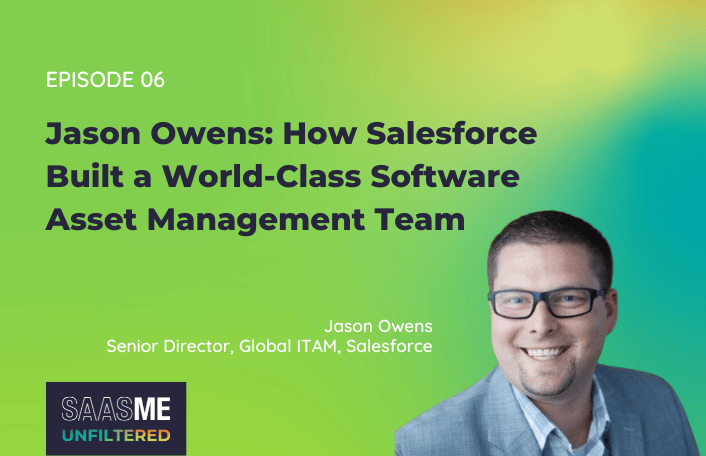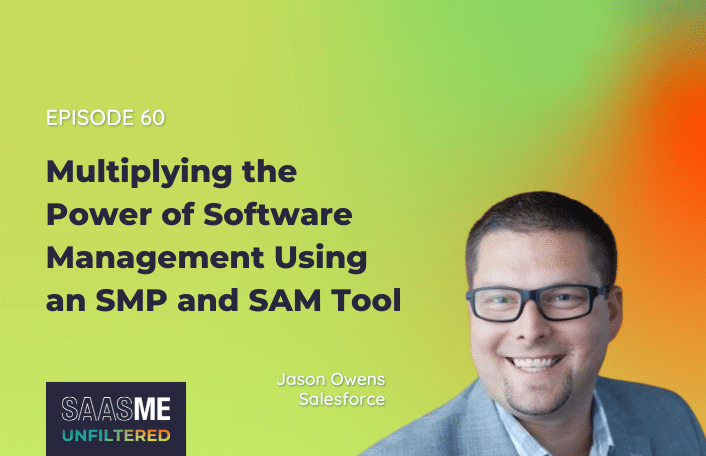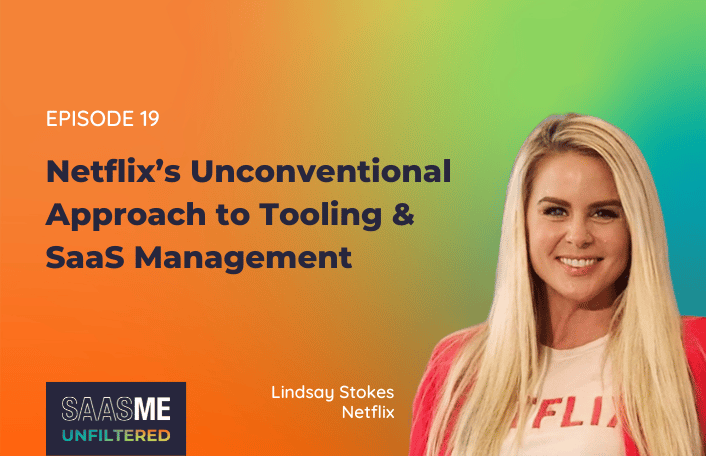
Jason Owens: How Salesforce Built a World-Class Software Asset Management Team
Table of Contents ToggleEpisode SummaryGuest SpotlightEpisode HighlightsCreate a Program that Pays...
Back
Back
Search for Keywords...
Blog

05/09/2024
Table of Contents
Double your insights and control with a combined SaaS Management Platform and Software Asset Management strategy. SAM tools excel at on-premises management, but SMPs uncover the invisible: longtail SaaS apps, shadow IT, and hidden risks. In this episode, Jason Owens, Sr. Director, Global ITAM at Salesforce, reveals the magic of using both an SMP and SAM tool – unparalleled visibility, cost optimization, and streamlined management you get using them together.
Listen to the full episode on Spotify or Apple Podcasts.
According to Jason Owens, Sr. Director, Global ITAM at Salesforce, Software Asset Managers are critical to “leading, spearheading, or evangelizing the digital transformations of their companies.” In fact, they’re the most well-positioned to drive business value across the enterprise.
But now, on-premises software and SaaS coexist within the tech stack, making it even more challenging to manage.
“You need to have both [a SMP and SAM tool],” explained Owens, “because you have two fundamentally different types of software in the enterprise.”
Different software models means different objectives. With on-prem, it’s a compliance and risk management activity that is reactive in nature. Meanwhile, SaaS Management is more proactive and focused on license management.
As Owens advised, “If we’re working in the proactive space versus the reactive space, we are setting ourselves up for future success.”.
Name: Jason Owens
What he does: Sr. Director, Global ITAM at Salesforce
Connect with Jason online: LinkedIn
“Today, software asset managers are, and should be responsible for either leading, spearheading, supporting, or evangelizing for the digital transformations of their companies. And what do I mean when I say that? It means that we have a collective responsibility, the 10 to 12, 000 software asset managers that exist in the world according to Forrester Research is that we have this great nexus of where we sit between security, information technology, finance, procurement, where we can advocate for business value unlike almost any other role that exists in either the enterprise or the SMB today.”
“There is a dichotomy when it comes to looking at compliance-focused traditional on-prem for license management and ELP delivery. And then there’s this SaaS stuff. We don’t really need ELPs because we can see our current license position in the portal at the drop of a hat. My belief is that it’s not an either-or, it’s a yes-and. You have to be able to deliver both of those, particularly today where there are companies, especially if you’re at the enterprise level, you still have a ton of legacy or traditional software models that grew out of a physical CD key that you had to catalog and keep in a drawer somewhere. To today where your ELP is literally just logging in and seeing what your portal says. You have to be able to do both effectively in order to manage your software portfolio. And it’s finding that healthy tension and where in your specific company, your enterprise, the low-hanging fruit and the largest value drivers are for your company that will bring value to you, and your career, and your company that they can either reinvest or return to stakeholders.”
“From the [traditional software] focus, my perspective is that that’s a compliance and risk management activity. It’s important, it has to be done. There is compliance risk of either an external audit or vendor audit that comes from defined license levels and deployment where the vendor doesn’t have visibility 100% of the time to what you have deployed. Whereas when it comes to a SaaS platform, both you and the vendor know at all times what you have deployed and what licenses you have access to. At that point, the focus for asset managers should not be on, ‘I’m maintaining compliance with my contract.’ It is, ‘Where are my opportunities to understand my usage and utilization models so that if I have people that are using a high-price software on a quarterly or biannual basis, that we’re not letting those people occupy a seat for 12 months out of the year.’ That we’re either finding something else for them to use or we’re creating mechanisms internally, either through automation or through license management practices, where we only give them the license where they need it.”
“The fundamental crux of the discussion is that we’re paying for something, and if we’re not receiving value for it, we shouldn’t be paying for it. We’ve had some difficult conversations with vendors over the last 18 months where we’ve said, ‘We know you see all these people that are logged in and have licenses assigned.’ When we look at the usage and utilization data, they’re not really getting the value out of X or Y percent of those seats. We need to have some tough conversations about that, because it’s also not great for the software vendor long-term in the marketplace if they just have people occupying seats as shelfware. I think that’s a discussion that I don’t think has reached a significant portion of the SaaS market yet, that it’s all about, ‘Let’s focus on viral, let’s get as many people in seats as we can. Let’s grow it organically.’ But if people are just occupying a seat just to charge for a license, that’s not a healthy relationship for either the consumer or the vendor that is selling the seat.”
“You need to have both [a SMP and SAM tool], because you have two fundamentally different types of software in the enterprise. You need to be able to manage them both… I think the fastest way to business value is with a SaaS Management platform. If you’re looking at the maturity model, and you’re at a zero, one, or even an early stage two, it probably makes sense to invest in a SaaS Management platform first, because you’re going to be able to show value realization to your executives on a much quicker timescale. And then you can use that to say, ‘This is why we also need to capture and manage on the other side.’ It’s not an either-or question. They’re very complimentary platforms. At the end of the day, the answer is you need to have both. And how you fit that into your specific situation is highly dependent on where you need to deliver business value and on what timeframe.”
“When it comes to the SaaS Management platform, it’s a much more proactively focused tool in that we’re saying on a monthly basis: What does our usage look like? Is our user base up or down? How are we looking for the percentage of users that have actually logged into the platform this month? Again, we come back to the yes-and better together story, but from a SaaS Management platform perspective, it really is focused more on the proactive activities. And I think as asset managers, we all know intrinsically that if we’re working in the proactive space versus the reactive space, we are setting ourselves up for future success. I like to tell my team this, ‘What are you doing today to make your job easier tomorrow?’ A SaaS Management platform, unlike pretty much any other platform that exists out there, is really a critical tool in the tool belt to make your job easier tomorrow. So tomorrow you look back and say, ‘Man, I’m really glad I did that yesterday.’ Not, ‘I wish I had done that yesterday.’”
12:26 – “[If] we’re paying for something, and if we’re not receiving value for it, we shouldn’t be paying for it.”
14:18 – “You need to have both [a SMP and SAM tool], because you have two fundamentally different types of software in the enterprise.”
20:38 – “If we’re working in the proactive space versus the reactive space, we are setting ourselves up for future success.”
Listen and subscribe to SaaSMe Unfiltered wherever you listen to podcasts.
ABOUT THE AUTHOR

Cory Wheeler
As Zylo’s Chief Customer Officer, Cory is responsible for helping our customers drive ROI and SaaS Management success with Zylo. He helps companies of all sizes effectively discover, optimize, and govern their SaaS through Zylo’s platform and services. Prior to founding Zylo, Cory spent 15 years in finance and procurement, managing categories and sourcing teams at Arthur Andersen, BearingPoint, and both Takeda and Astellas Pharmaceuticals. He built the procurement organization at ExactTarget, and managed the integration with the Salesforce Marketing Cloud procurement organization in 2015. He and his family reside in Indianapolis, IN, where they can be found cheering for the Purdue Boilermakers and Chicago Cubs.

Table of Contents ToggleEpisode SummaryGuest SpotlightEpisode HighlightsCreate a Program that Pays...

Table of Contents ToggleEpisode SummaryGuest SpotlightEpisode HighlightsSoftware Asset Managers Are Critical...

Table of Contents ToggleEpisode SummaryGuest SpotlightEpisode HighlightsHomegrown Tools Just Don’t Cut...

Table of Contents ToggleMyth #1: SaaS Is in the Cloud, So...
| Cookie | Duration | Description |
|---|---|---|
| cookielawinfo-checkbox-analytics | 11 months | This cookie is set by GDPR Cookie Consent plugin. The cookie is used to store the user consent for the cookies in the category "Analytics". |
| cookielawinfo-checkbox-functional | 11 months | The cookie is set by GDPR cookie consent to record the user consent for the cookies in the category "Functional". |
| cookielawinfo-checkbox-necessary | 11 months | This cookie is set by GDPR Cookie Consent plugin. The cookies is used to store the user consent for the cookies in the category "Necessary". |
| cookielawinfo-checkbox-others | 11 months | This cookie is set by GDPR Cookie Consent plugin. The cookie is used to store the user consent for the cookies in the category "Other. |
| cookielawinfo-checkbox-performance | 11 months | This cookie is set by GDPR Cookie Consent plugin. The cookie is used to store the user consent for the cookies in the category "Performance". |
| viewed_cookie_policy | 11 months | The cookie is set by the GDPR Cookie Consent plugin and is used to store whether or not user has consented to the use of cookies. It does not store any personal data. |
